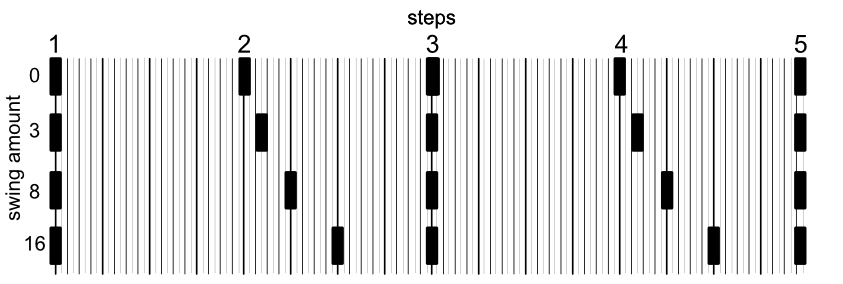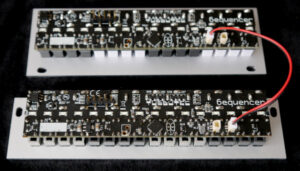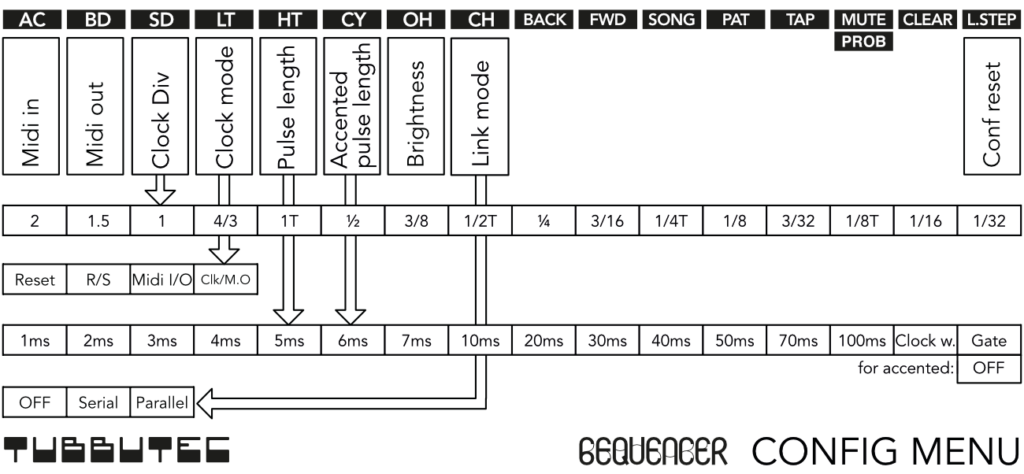
TR-606 inspired drum sequencer in 3U and 1U eurorack
Introduction
Tubbutec 6equencer (pronounced sequencer, sixquencer, or whatever you prefer) is a TR-606 inspired step sequencer.
It is available in different Eurorack form factors (1U and 3U) and despite being compact has many powerful features.
6equencer is optimized for live performance and allows quick programming and editing of drum patterns.
Features
- Step based drum sequencer with 8 instruments inspired by the TR-606.
- Compatible with analogue and midi based systems
- 16 patterns, chainable in song mode, up to 32 patterns in a song
- Forward, backward, ping-pong and random play directions for patterns and songs
- Mute instruments live
- Probability control of steps
- NEW: Swing with adjustable amount
- NEW: Various types of Flam or Ratchet effects
- Record steps by tapping or via midi
- Clear steps while playing
- Pattern length can be set individually (Last Step)
- Copy, Paste and Clear patterns in song mode
- 8 trigger outputs with adjustable trigger length, midi out
- Analogue clock or midi clock input with adjustable clock divider
- Multiple 6equencers can be chained to achieve longer sequences or more instruments.
- Trigger and record via midi in, doubles as midi interface
- Trigger midi instruments via midi out
- Very compact, yet versatile: 3U * 6HP, or 1U * 24HP Intellijel
- For a detailed list and explanation of features, please refer to the user manual (PDF), which is also included with the 6equencer.
- Firmware update is possible via midi sysex
User interface
The 6equencer user interface features 16 buttons with LEDs and a FUNC button.
Each LED can be red, blue or purple.
Typically a blue LED will indicate a mode or setting, while a red LED will indicate an active step or parameter.
When both, red and blue LEDs are turned on, the resulting color will be purple. This means both are set (e.g. a step is set and a parameter is selected).
Inputs and Outputs
The clock input doubles as a midi input, the RESET or RUN/STOP input doubles as midi output.
It is possible to trigger analogue drum modules, analogue drum machines or midi based drum machines.
Drum patterns and songs
Multiple patterns can be chained to a ‘song’. Each song consists of up to 32 patterns, a single pattern can occur multiple times in a song.
You can record a new song while another is playing and start the new song in sync. This allows very flexible and intuitive live performances.
Performance features
Many features exist to ease pattern programming and live performance:
In CLEAR mode, the current steps are cleared as long as CLEAR is pressed.
Swing
When swing is activated, every second step is delayed by a time proportional to the step length. Fifteen swing amounts are possible ranging from 1/32th to 16/32th.
The maximum setting of 16 results in a 3-to-1 rhythm, a setting of 8 in a 5-to-3 rhythm.
You can use one of the trigger outputs to clock other gear, effectively converting a straight clock into a ‘swung’ clock.
Ratchet and Flam
Multiple flam types are available. Three of them create subdivisions of a single step, and four span multiple steps.
The effect is triggered by an instrument channel and is affected by mute and probability. This can create sequences with flams or triplets inserted randomly.
Link multiple 6equencers
Multiple 6equencer modules can be connected to form patterns with more than 16 steps or used in parallel to effectively get more instrument channels.
Up to 4 6equencers can be connected for a maximum of 64 steps per pattern or 32 instrument channels. The connection is achieved via a ‘LINK’ connector on the back of the module.

Config Menu
You can define
- Midi input and output channels
- Pulse lengths or gate output
- Accented pulse length
- Clock mode
- Clock dividers
- LED brightness
- LINK mode
- Analog clock divider
- Swing amount
It is rarely necessary to change settings in the config menu, but to ease its use reference cards are provided.
User Manual
For a detailed list and explanation of features, please refer to the user manual (PDF), which is also included with the 6equencer. There are a lot more features than listed here.
Manuel de l’utilisateur (French manual) by Auditorial, thank you very much!
FAQ
Q: Is there a 1U Tile (Pulp Logic) version?
A: Yes, you can purchase it in our shop.














